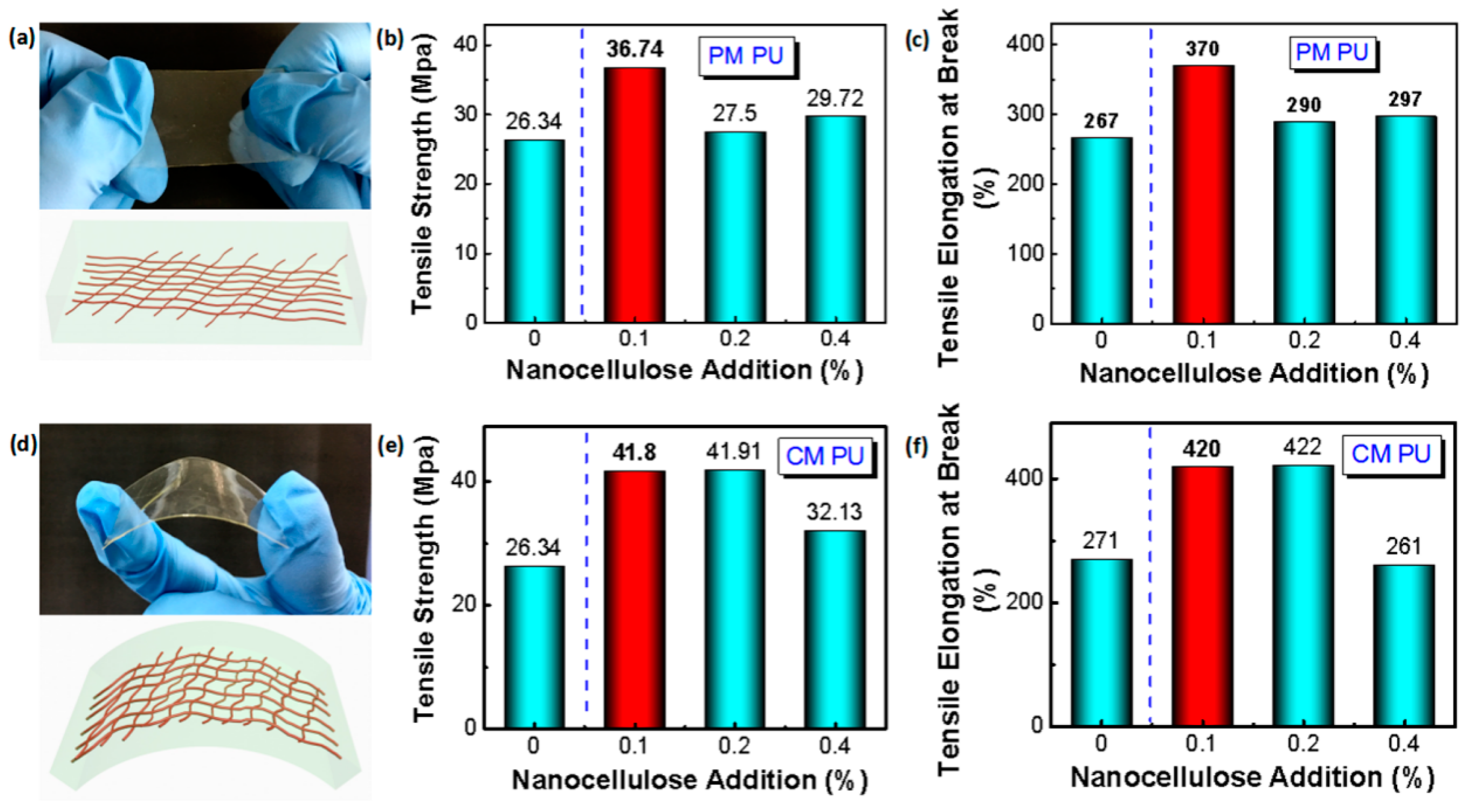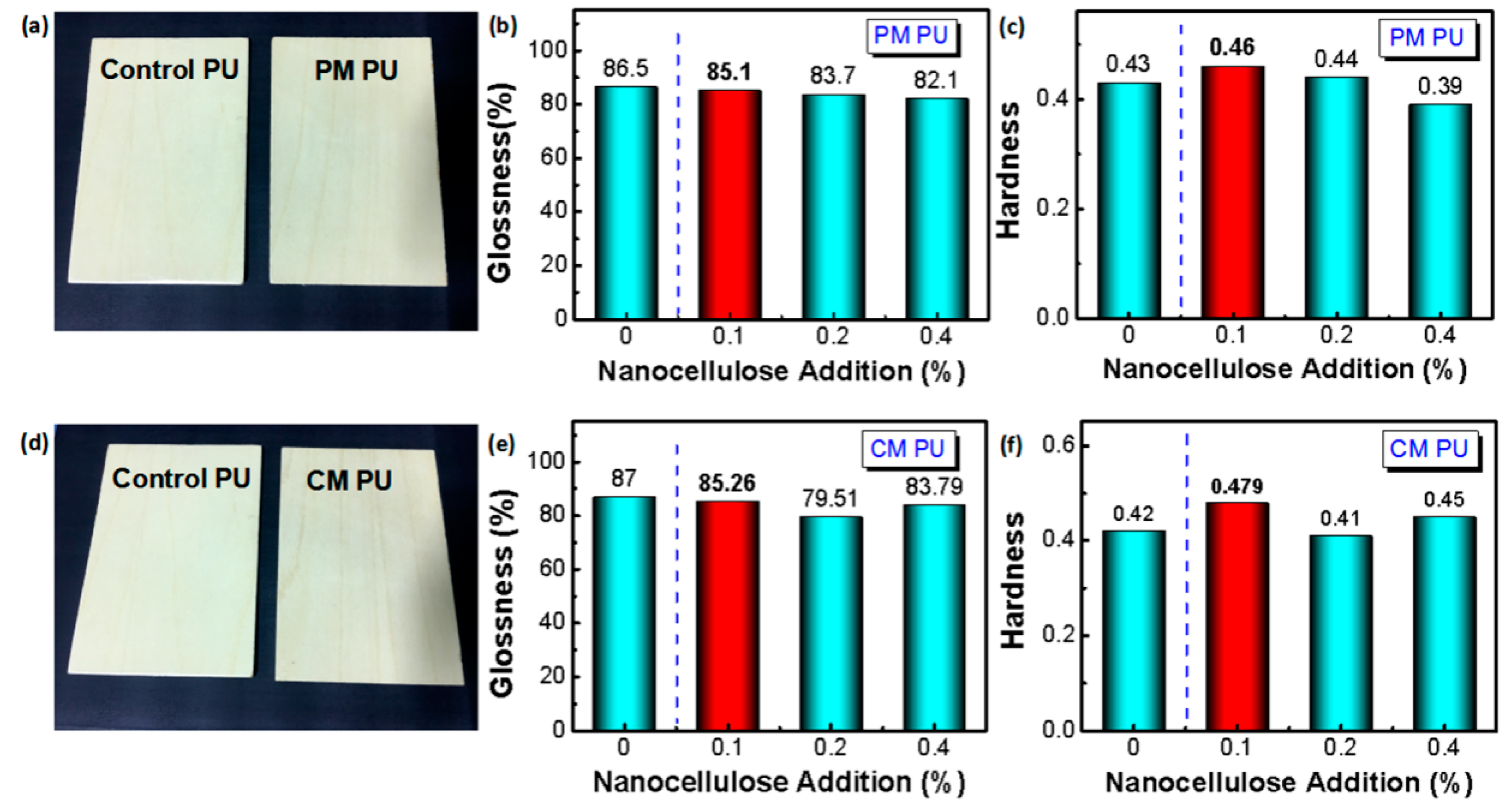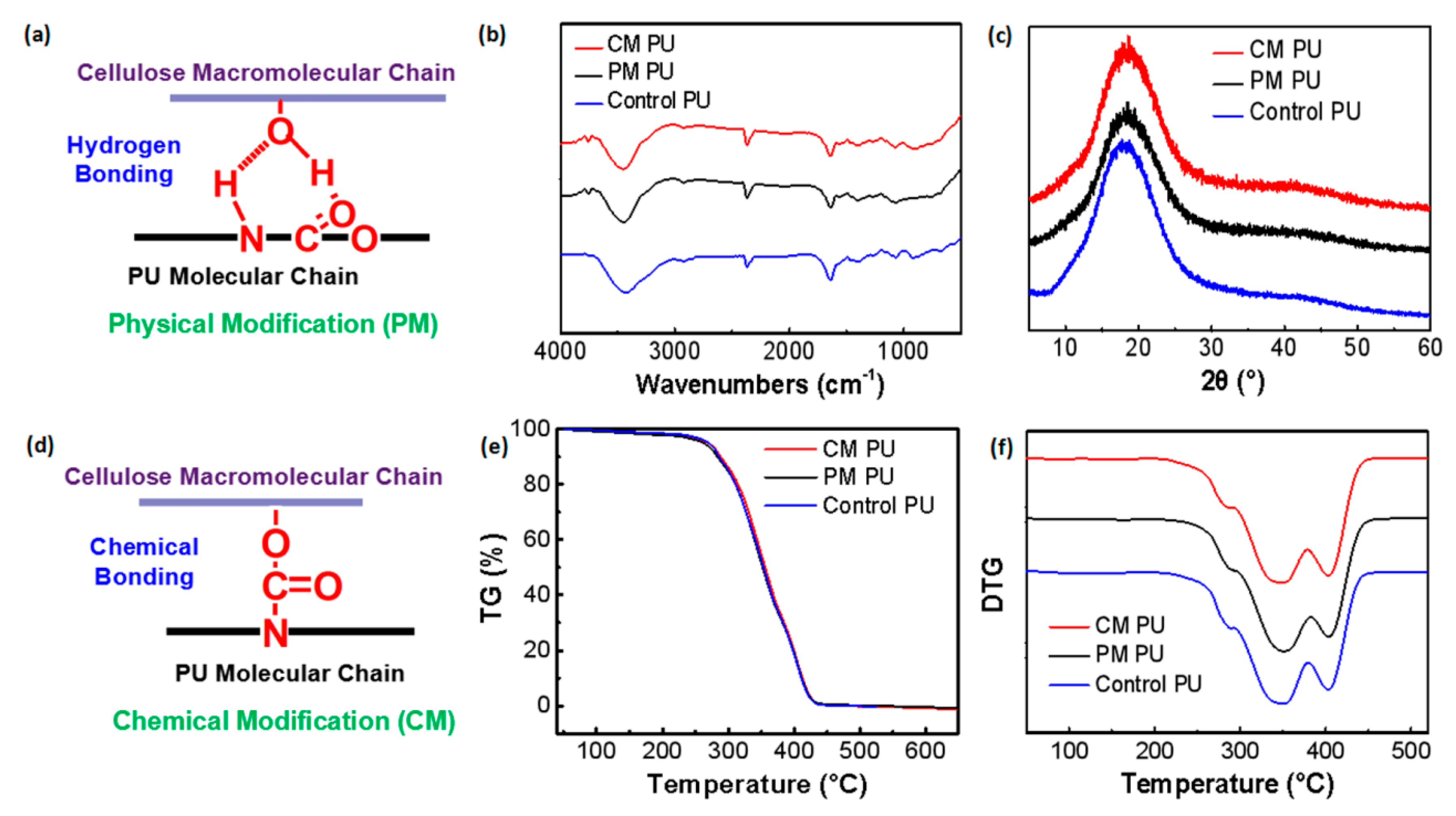Nanocellulose-Reinforced Polyurethane for Waterborne Wood Coating
Abstract
:1. Introduction
2. Discussion
3. Materials and Methods
3.1. Experimental Materials
3.2. Experimental Methods
3.2.1. Preparation of Nanocellulose
3.2.2. Preparation of Waterborne Polyurethane Emulsion
- (1)
- Dehumidification treatment of Polypropylene glycol 2000, 1,4-butanediol and dimethylolpropionic acid under vacuum conditions (0.09 MPa) at 110 °C for 100 min;
- (2)
- Reaction of isopropanone diisocyanate and polypropylene glycol 2000 at a molar ratio of 1.5:1 under 65 °C for 1.5 h.
- (3)
- Chain extending process of adding a quantitative solution of 1,4-butanediol/acetone into the above solution (step 2) at 70–80 °C for 1.5 h.
- (4)
- Hydrophilic process of quantitatively adding dimethylolpropionic acid/N-methylpyrrolidone solution into the step 3 solution at about 70 °C for 3.5 h, during which acetone is employed to regulate the viscosity.
- (5)
- Neutralization process of adding an appropriate amount of triethylamine into the reaction system at room temperature and stirring for 15 min.
- (6)
- Emulsifying process of adding quantitative deionized water into the above solution of step 5 at high-speed blending of 12,000 rpm for 20 min to obtain an aqueous polyurethane emulsion.
3.2.3. Physical Modification of Waterborne Polyurethane by Nanocellulose
3.2.4. Chemical Modification of Waterborne Polyurethane by Nanocellulose
3.2.5. Characterization and Properties Evaluation of the PU Paint
- (1)
- Scanning electron microscopy (SEM) observation. The microstructures of the PU films were observed by scanning electron microscopy (FE-SEM, JEM-6610LV, JEOL USA Inc., Peabody, MA, USA). The test conditions include high vacuum mode, working voltage of 12.5 kV, and beam spot of 5.0.
- (2)
- Transmission electron microscopy (TEM) observation. The derived different PU emulsions were observed by transmission electron microscope (TEM, JEM-1400, JEOL USA Inc., Peabody, MA, USA). The PU emulsion was dropped onto copper screen and then negatively stained by phosphotungstic acid and finally dried at room temperature before examination.
- (3)
- Atomic force microscopy (AFM) observation. The derived different PU emulsions were characterized by Atomic Force Microscope (AFM, NaioAFM, Nanosurf AG, Liestal, Switzerland) with tapping mode. The PU emulsion was dropped onto mica plate and dried at room temperature for further examination.
- (4)
- X-ray diffraction (XRD) characterization. The crystal structure and crystallinity of the PU films were characterized by X-ray diffractometer (XRD, D/max 2200, Rigaku Americas Corporation, Woodlands, TX, USA). The test parameters include a copper target, ray wavelength of 0.154 nm, scanning angle from 5° to 60°, scanning speed of 4 (°)/min, step of 0.02°, voltage of 40 kV, and current of 30 mA.
- (5)
- Fourier transform infrared (FTIR) characterization. The FTIR spectra were obtained using a Nicolet Magna 560 FTIR instrument (Thermo Nicolet Inc., Madison, WI, USA). The test parameters were resolution of 4 cm-1 and scans number of 32 times. Placing the sample on the diamond ATR accessory of the sample stage and adjusting the pressure column to the appropriate location for the test.
- (6)
- Thermogravimetric (TG) characterization. The thermal stability of the PU films were tested by a Thermogravimetric Analyzer (TGA Q500, Waters, New Castle, DE, USA) instrument. Five to ten mg samples were employed for the test with conditions of continuous nitrogen flow, heat rate of 10 °C/min and the temperature ranged from 35 °C to 450 °C.
- (7)
- Tensile strength and elongation at break measurement—the test was carried out using a microcomputer-controlled electronic universal testing machine (Jinan Test Group Co., Ltd., Jinan, China) with the model of WDW-5E according to the GB/T1040-1992: “Test Methods for Tensile Properties of Plastics.” The paint film was cut into dumbbell shape with standard cutter, which was 115 mm in total length, 80 mm in clamp space, 35 mm in gauge length and 6 mm in width in the middle parallel part. Each test result was mean value of three experimental data.
- (8)
- Abrasion resistance test. The test was carried out using a BGD523 type paint film abrasion tester according to the GB/T1768-2006: “Physical and Chemical Performance Test of Furniture Surface Paint Film—Part 8: Measurement Method of Abrasion Resistance.” Three pieces of maple veneer were sprayed and cut into square pieces of 100 mm × 100 mm with a small hole in the middle. The abrasion test was conducted under conditions of 800# sandpaper pasted on the grinding wheel with double-sided tape and the two arms with 1000 g weight pressed on the wood samples for rotation of 250 circles. The experimental results were averaged from three experimental data that were measured by weighing the mass loss before and after abrasion.
- (9)
- Glossiness test. The test was carried out using a GZ-II three-angle gloss tester according to GB/T 4896.6-2013: “Physical and Chemical Performance Test of Furniture Surface Paint Film—Part 6: Gloss measurement.” Three pieces of Maple veneer were sprayed with the PU paint and the glossiness was the mean value of three experimental data. Before the test, the gloss tester was calibrated by a standard plate.
- (10)
- Hardness test. The test was conducted by a pendulum hardness tester (Guangzhou Biuged BGD 508) according to GB/T 1730-1993: “Determination of Paint Film Hardness—–Pendulum Damping Test.” The result was the mean value of three experimental data.
- (11)
- Drying time test—the test was carried out according to GB/T 1728-1979: “Method for determining drying time of paint film and putty film.” The drying process was carried out in a constant temperature and humidity chamber with temperature of 30 °C and humidity of 50%. The experimental result was the mean value of three experimental data.
4. Conclusions
- (1)
- Nanocellulose, with a 10nm diameter and an aspect ratio of over 1000—which is derived from a biomass material by the TEMPO oxidation method—could be uniformly dispersed in the waterborne polyurethane emulsion with an entangled network structure.
- (2)
- The tensile strength, tensile elongation at break, glossiness and hardness of the CM PU and the PM PU at 0.1 wt% nanocellulose addition presents the highest value in the three nanocellulose additions of the corresponded PU modification, respectively; and the CM PU reaches the highest values when compared to the PM PU and the control PU; suggesting that such a method could effectively improve the comprehensive properties of PU and broaden the applications of nanocellulose and waterborne PU coating.
Author Contributions
Funding
Acknowledgments
Conflicts of Interest
References
- Nikolic, M.; Lawther, J.M.; Sanadi, A.R. Use of nanofillers in wood coatings: A scientific review. J. Coat. Technol. Res. 2015, 12, 445–461. [Google Scholar] [CrossRef]
- Noreen, A.; Zia, K.M.; Zuber, M.; Tabasum, S.; Saif, M.J. Recent trends in environmentally friendly water-borne polyurethane coatings: A review. Korean J. Chem. Eng. 2015, 33, 388–400. [Google Scholar] [CrossRef]
- Xu, S.; Girouard, N.; Schueneman, G.; Shofner, M.L.; Meredith, J.C. Mechanical and thermal properties of waterborne epoxy composites containing cellulose nanocrystals. Polymer 2013, 54, 6589–6598. [Google Scholar] [CrossRef]
- Veigel, S.; Grüll, G.; Pinkl, S.; Obersriebnig, M.; Müller, U.; Gindl-Altmutter, W. Improving the mechanical resistance of waterborne wood coatings by adding cellulose nanofibres. React. Funct. Polym. 2014, 85, 214–220. [Google Scholar] [CrossRef]
- Vardanyan, V.; Poaty, B.; Chauve, G.; Landry, V.; Galstian, T.; Riedl, B. Mechanical properties of UV-waterborne varnishes reinforced by cellulose nanocrystals. J. Coat. Technol. Res. 2014, 11, 841–852. [Google Scholar] [CrossRef]
- Bettaieb, F.; Khiari, R.; Dufresne, A.; Mhenni, M.F.; Belgacem, M.N. Mechanical and thermal properties of Posidonia oceanica cellulose nanocrystal reinforced polymer. Carbohydr. Polym. 2015, 123, 99–104. [Google Scholar] [CrossRef]
- Nkeuwa, W.N.; Riedl, B.; Landry, V. Wood surfaces protected with transparent multilayer UV-cured coatings reinforced with nanosilica and nanoclay. Part I: Morphological study and effect of relative humidity on adhesion strength. J. Coat. Technol. Res. 2014, 11, 283–301. [Google Scholar] [CrossRef]
- Nkeuwa, W.N.; Riedl, B.; Landry, V. Wood surfaces protected with transparent multilayer UV-cured coatings reinforced with nanosilica and nanoclay. Part II: Pplication of a standardized test method to study the effect of relative humidity on scratch resistance. J. Coat. Technol. Res. 2014, 11, 993–1011. [Google Scholar] [CrossRef]
- Nkeuwa, W.N.; Riedl, B.; Landry, V. UV-cured clay/based nanocomposite topcoats for wood furniture: Part I: Morphological study, water vapor transmission rate and optical clarity. Prog. Org. Coat. 2014, 77, 1–11. [Google Scholar] [CrossRef]
- Nkeuwa, W.N.; Riedl, B.; Landry, V. UV-cured clay/based nanocomposite topcoats for wood furniture. Part II: Dynamic viscoelastic behavior and effect of relative humidity on the mechanical properties. Prog. Org. Coat. 2014, 77, 12–23. [Google Scholar] [CrossRef]
- Cristea, M.V.; Riedl, B.; Blanchet, P. Effect of addition of nanosized UV absorbers on the physico-mechanical and thermal properties of an exterior waterborne stain for wood. Prog. Org. Coat. 2011, 72, 755–762. [Google Scholar] [CrossRef]
- Cristea, M.V.; Riedl, B.; Blanchet, P. Enhancing the performance of exterior waterborne coatings for wood by inorganic nanosized UV absorbers. Prog. Org. Coat. 2010, 69, 432–441. [Google Scholar] [CrossRef]
- Sow, C.; Riedl, B.; Blanchet, P. Kinetic studies of UV-waterborne nanocomposite formulations with nanoalumina and nanosilica. Prog. Org. Coat. 2010, 67, 188–194. [Google Scholar] [CrossRef]
- Sow, C.; Riedl, B.; Blanchet, P. UV-waterborne polyurethane-acrylate nanocomposite coatings containing alumina and silica nanoparticles for wood: Mechanical, optical, and thermal properties assessment. J. Coat. Technol. Res. 2011, 8, 211–221. [Google Scholar] [CrossRef]
- Landry, V.; Riedl, B.; Blanchet, P. Alumina and zirconia acrylate nanocomposites coatings for wood flooring: Photocalorimetric characterization. Prog. Org. Coat. 2008, 61, 76–82. [Google Scholar] [CrossRef]
- Pu, Y.; Zhang, J.; Elder, T.; Deng, Y.; Gatenholm, P.; Ragauskas, A.J. Investigation into nanocellulosics versus acacia reinforced acrylic films. Compos. Part B Eng. 2007, 38, 360–366. [Google Scholar] [CrossRef]
- Saralegi, A.; Rueda, L.; Martin, L.; Arbelaiz, A.; Eceiza, A.; Corcuera, M.A. From elastomeric to rigid polyurethane/cellulose nanocrystal bionanocomposites. Compos. Sci. Technol. 2013, 88, 39–47. [Google Scholar] [CrossRef]
- Meyabadi, T.F.; Sadeghi, G.M.M.; Dadashian, F.; Asl, H.E.Z. From cellulosic waste to nanocomposites. Part 2: Synthesis and characterization of polyurethane/cellulose nanocomposites. J. Mater. Sci. 2013, 48, 7283–7293. [Google Scholar] [CrossRef]
- Rueda, L.; Saralegui, A.; d’Arlas, B.F.; Zhou, Q.; Berglund, L.A.; Corcuera, M.A.; Mondragon, I.; Eceiza, A. Cellulose nanocrystals/polyurethane nanocomposites. Study from the viewpoint of microphase separated structure. Carbohydr. Polym. 2013, 92, 751–757. [Google Scholar] [CrossRef]
- Wu, Q.; Henriksson, M.; Liu, X.; Berglund, L.A. A High Strength Nanocomposite Based on Microcrystalline Cellulose and Polyurethane. Biomacromolecules 2007, 8, 3687–3692. [Google Scholar] [CrossRef]
- Lin, N.; Wei, S.; Xia, T.; Hu, F.; Huang, J.; Dufresne, A. Green bionanocomposites from high-elasticity “soft” polyurethane and high-crystallinity “rigid” chitin nanocrystals with controlled surface acetylation. RSC Adv. 2014, 4, 49098–49107. [Google Scholar] [CrossRef]
- Poaty, B.; Vardanyan, V.; Wilczak, L.; Chauve, G.; Riedl, B. Modification of cellulose nanocrystals as reinforcement derivatives for wood coatings. Prog. Org. Coat. 2014, 77, 813–820. [Google Scholar] [CrossRef]
- Pei, A.; Malho, J.-M.; Ruokolainen, J.; Zhou, Q.; Berglund, L.A. Strong Nanocomposite Reinforcement Effects in Polyurethane Elastomer with Low Volume Fraction of Cellulose Nanocrystals. Macromolecules 2011, 44, 4422–4427. [Google Scholar] [CrossRef]
- Dai, L.; Long, Z.; Ren, X.-H.; Deng, H.-B.; He, H.; Liu, W. Electrospun polyvinyl alcohol/waterborne polyurethane composite nanofibers involving cellulose nanofibers. J. Appl. Polym. Sci. 2014, 131, 41051. [Google Scholar] [CrossRef]
- Zhou, X.; Sain, M.M.; Oksman, K. Semi-rigid biopolyurethane foams based on palm-oil polyol and reinforced with cellulose nanocrystals. Compos. Part A Appl. Sci. Manuf. 2015, 83, 56–62. [Google Scholar] [CrossRef]
- Li, W.; Yang, R.; Wu, Y.; Huang, Q.; Ke, J. Method for Preparing Nanocellulose-Polyurethane Iridescent Structural Color Coating for Wood Products. Patent CN 109575696A, 5 April 2019. [Google Scholar]
- Zhuo, X.; Liu, C.; Pan, R.; Dong, X.; Li, Y. Nanocellulose mechanically isolated from Amorpha fruticosa Linn. ACS Sustain. Chem. Eng. 2017, 5, 4414–4420. [Google Scholar] [CrossRef]
- Zhuo, X.; Wei, J.; Xu, J.; Pan, R.; Zhang, G.; Guo, Y.; Dong, X.; Long, L.; Li, Y. Nanocellulose isolation from Amorpha fruticose by an enzyme-assisted pretreatment. Appl. Environ. Biotechnol. 2017, 2, 34–39. [Google Scholar] [CrossRef]
- Wei, J.; Gui, S.; Wu, J.; Xu, D.; Sun, Y.; Dong, X.; Dai, Y.; Li, Y. Nanocellulose-Graphene Oxide Hybrid Aerogel for Water Purification. Appl. Environ. Biotechnol. 2019, 4, 11–17. [Google Scholar]
- Wei, J.; Yang, Z.; Sun, Y.; Wang, C.; Fan, J.; Kang, G.; Zhang, R.; Dong, X.; Li, Y. Nanocellulose-based magnetic hybrid aerogel for adsorption of heavy metal ions from water. J. Mater. Sci. 2019, 54, 6709–6718. [Google Scholar] [CrossRef]
- Grüneberger, F.; Künniger, T.; Zimmermann, T.; Arnold, M. Rheology of nanofibrillated cellulose/acrylate systems for coating applications. Cellulose 2014, 21, 1313–1326. [Google Scholar] [CrossRef]
- Li, Y.; Dong, X. Method for Chemically Modifying Waterborne Wood Lacquer Containing Hemicellulose Nanocellulose. Patent CN 109251648A, 22 January 2019. [Google Scholar]
- Vardanyan, V.; Galstian, T.; Riedl, B. Effect of addition of cellulose nanocrystals to wood coatings on color changes and surface roughness due to accelerated weathering. J. Coat. Technol. Res. 2015, 12, 247–258. [Google Scholar] [CrossRef]
- Vardanyan, V.; Galstian, T.; Riedl, B. Characterization of cellulose nanocrystals dispersion in varnishes by backscattering of laser light. J. Coat. Technol. Res. 2015, 12, 647–656. [Google Scholar] [CrossRef]
- Cheng, F.; Huang, X.; Qi, H.; Liu, D.; Jiang, X. Nano-Scale Cellulose Functional Doping Modified Coating and Preparation Method Thereof. Patent CN 109054584A, 21 December 2018. [Google Scholar]
- Dong, X.; Zhuo, X.; Wei, J.; Zhang, G.; Li, Y. Wood-Based Nanocomposite Derived by in Situ Formation of Organic–Inorganic Hybrid Polymer within Wood via a Sol–Gel Method. ACS Appl. Mater. Interfaces 2017, 9, 9070–9078. [Google Scholar] [CrossRef] [PubMed]
- Wei, J.; Zhang, G.; Dong, J.; Wang, H.; Guo, Y.; Zhuo, X.; Li, C.; Liang, H.; Gu, S.; Li, C.; et al. Facile, Scalable Spray-Coating of Stable Emulsion for Transparent Self-Cleaning Surface of Cellulose-Based Materials. ACS Sustain. Chem. Eng. 2018, 6, 11335–11344. [Google Scholar] [CrossRef]
Sample Availability: Samples of the compounds are not available from the authors. |






© 2019 by the authors. Licensee MDPI, Basel, Switzerland. This article is an open access article distributed under the terms and conditions of the Creative Commons Attribution (CC BY) license (http://creativecommons.org/licenses/by/4.0/).
Share and Cite
Kong, L.; Xu, D.; He, Z.; Wang, F.; Gui, S.; Fan, J.; Pan, X.; Dai, X.; Dong, X.; Liu, B.; et al. Nanocellulose-Reinforced Polyurethane for Waterborne Wood Coating. Molecules 2019, 24, 3151. https://doi.org/10.3390/molecules24173151
Kong L, Xu D, He Z, Wang F, Gui S, Fan J, Pan X, Dai X, Dong X, Liu B, et al. Nanocellulose-Reinforced Polyurethane for Waterborne Wood Coating. Molecules. 2019; 24(17):3151. https://doi.org/10.3390/molecules24173151
Chicago/Turabian StyleKong, Linglong, Dandan Xu, Zaixin He, Fengqiang Wang, Shihan Gui, Jilong Fan, Xiya Pan, Xiaohan Dai, Xiaoying Dong, Baoxuan Liu, and et al. 2019. "Nanocellulose-Reinforced Polyurethane for Waterborne Wood Coating" Molecules 24, no. 17: 3151. https://doi.org/10.3390/molecules24173151




